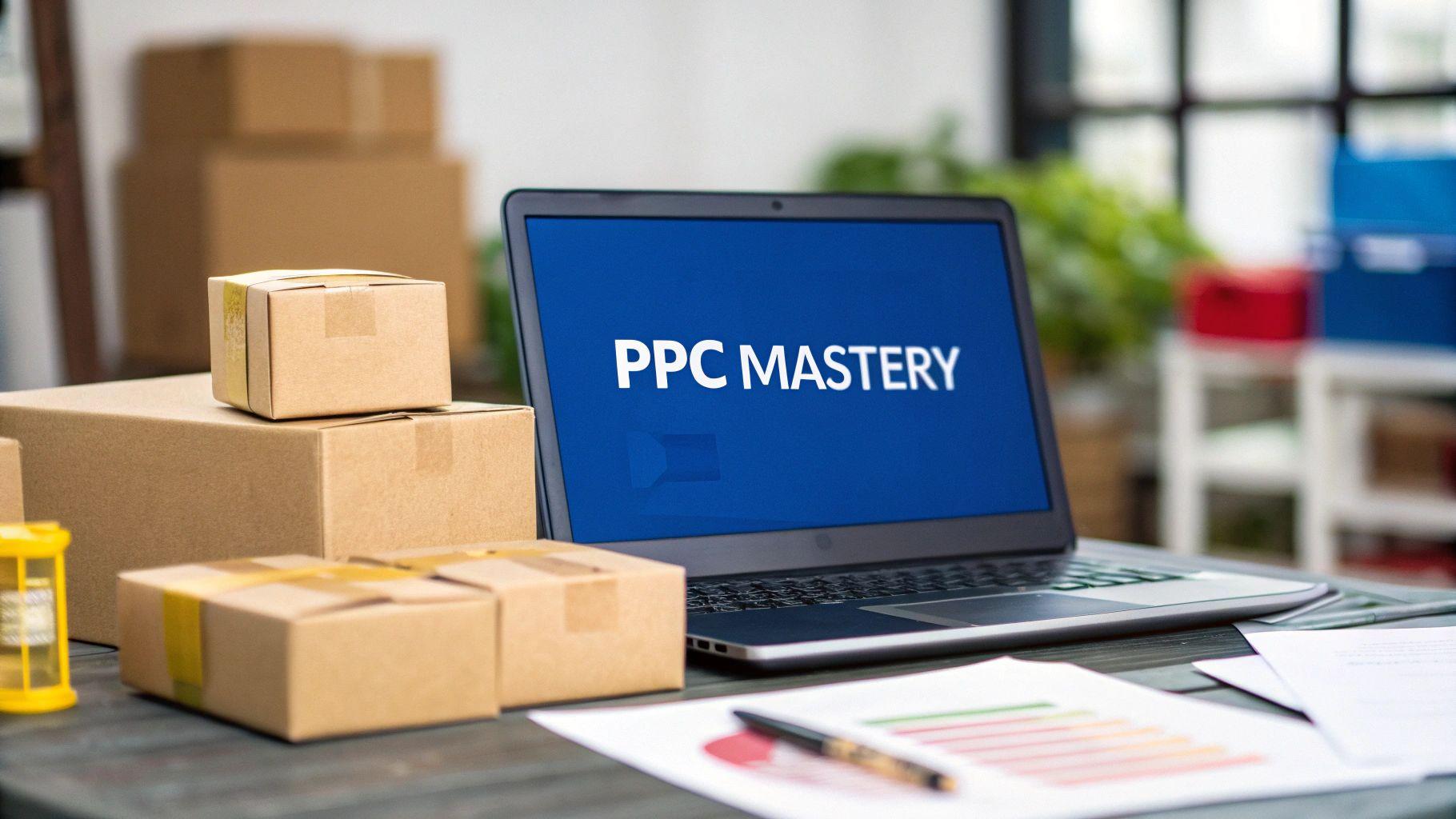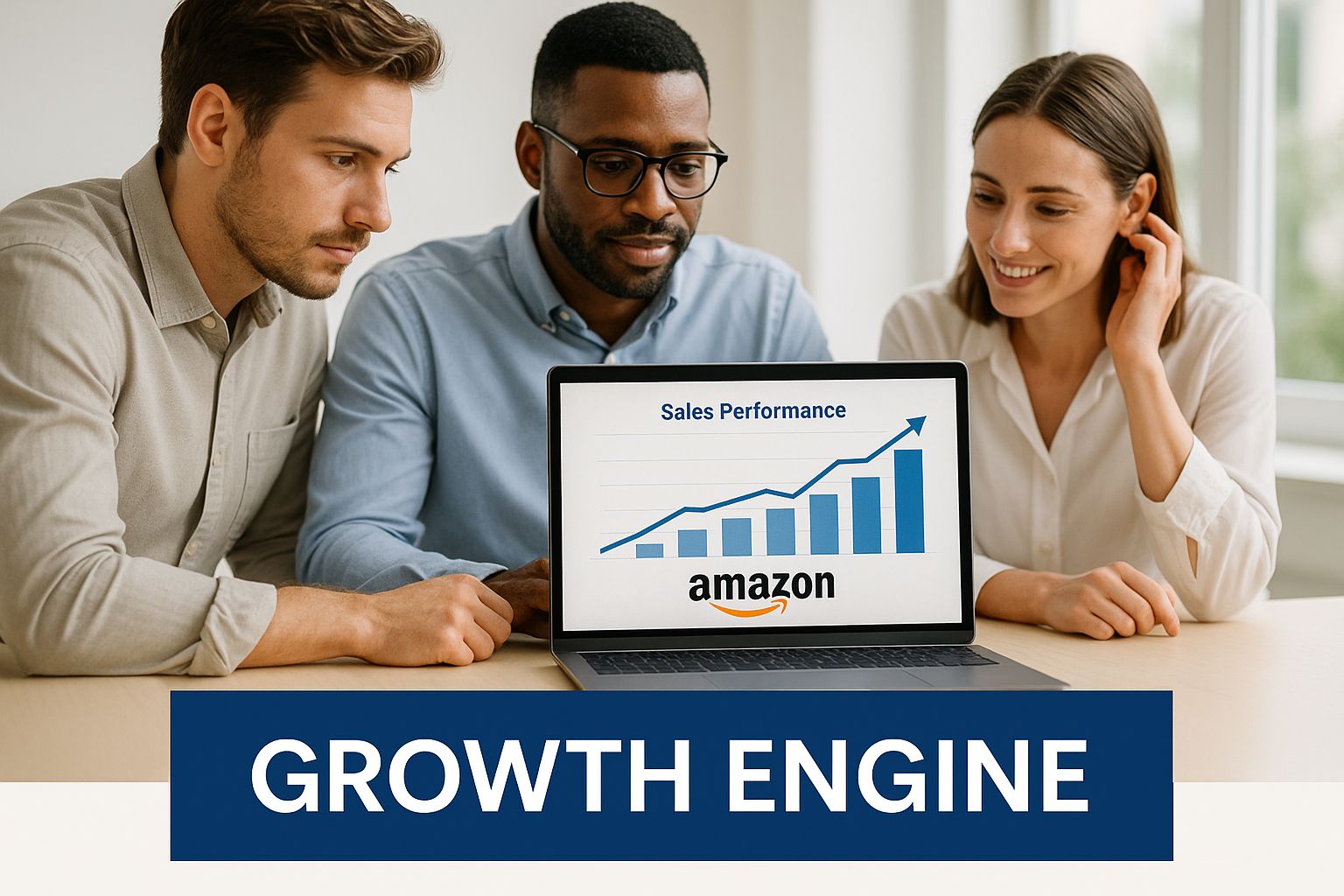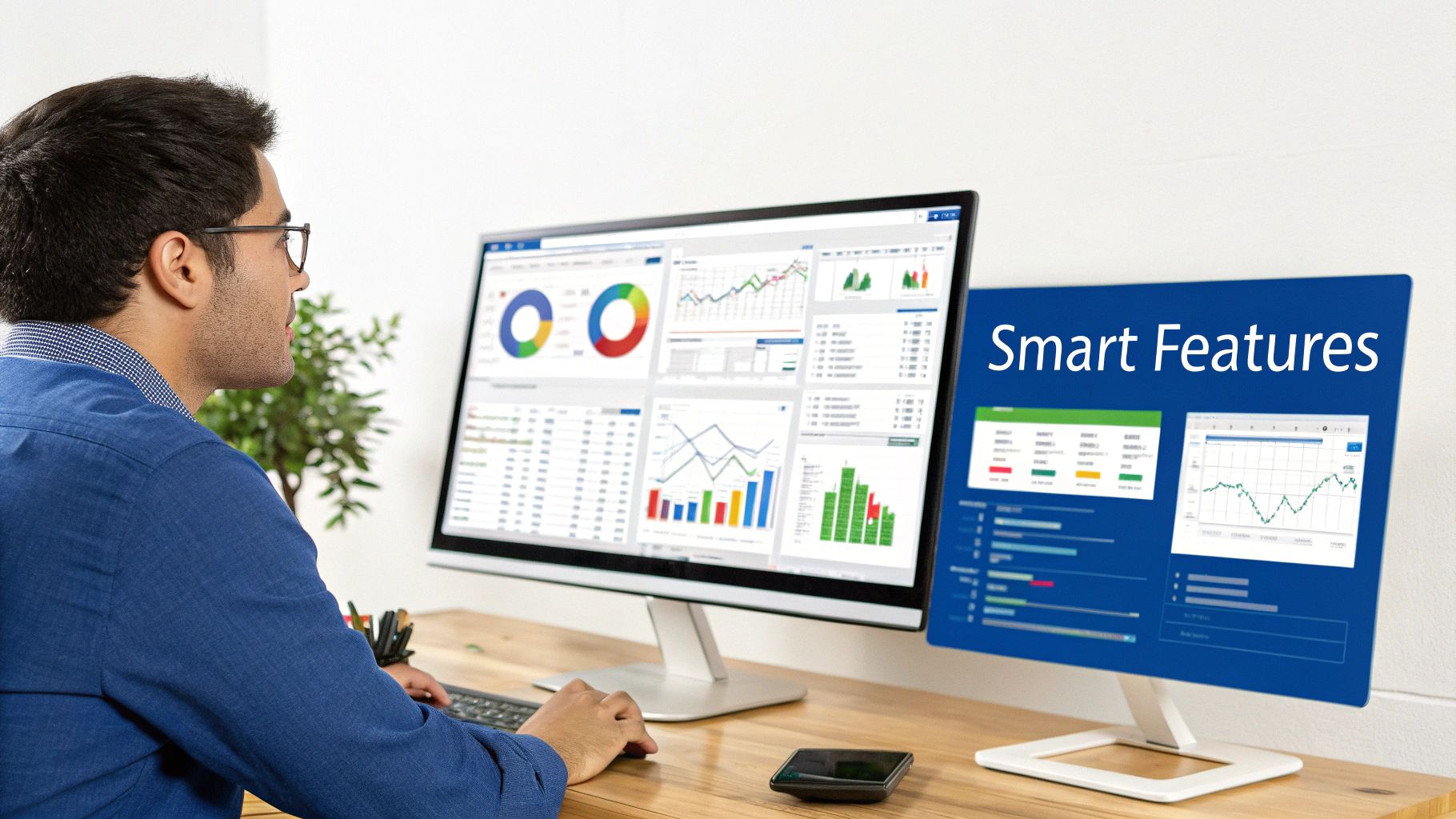How the Smartest Brands Choose Amazon PPC Management Software
Discover how the right Amazon PPC management software drives profit and organic rank. Our guide helps you choose the best tool for sustainable brand growth.

Viewing Amazon PPC management software as just another tool to manage ad spend is a critical mistake. For leading brands, it's the strategic command center that transforms advertising from a cost center into the primary engine for organic growth, market share capture, and sustainable profitability. It’s about connecting every ad dollar to a tangible business outcome, from inventory velocity to your brand's overall standing in the market.
Rethinking PPC: From Cost Center to Growth Engine
For too long, the default Amazon PPC strategy has been defensive: keep the Advertising Cost of Sale (ACOS) as low as possible. This narrow focus on efficiency misses the entire point of advertising on Amazon. The most sophisticated brands understand that strategic PPC spend is the catalyst for the Amazon flywheel—the virtuous cycle where paid visibility drives sales, which in turn boosts organic rank, leading to even more sales and solidifying market leadership.
PPC stops being a simple expense and becomes a strategic investment in this growth loop.
The Flywheel Effect in Action: A Performance-First Approach
This is the core principle behind elite amazon ppc management software. These platforms move beyond basic bid management to facilitate a holistic growth strategy. The primary KPI shifts from ACOS to Total Advertising Cost of Sale (TACOS), which measures ad spend against total revenue (paid and organic). A consistently decreasing TACOS is the clearest indicator that your ad investment is successfully building long-term brand equity, not just renting short-term traffic.
A performance-first approach, powered by the right software, allows you to leverage PPC to achieve outcomes that truly matter:
- Accelerating Organic Rank: A 2022 study by Perpetua found a direct correlation between sustained ad-driven sales and a significant lift in organic search placement. By targeting high-intent keywords, you signal relevance to Amazon's A9 algorithm, which rewards your product with higher organic visibility.
- Optimizing Inventory Velocity: Strategic advertising prevents stock from stagnating. High sales velocity is a crucial factor in Amazon’s Inventory Performance Index (IPI), directly impacting your storage limits and FBA fees. The right software helps align ad spend with inventory levels, preventing costly stockouts during peak demand.
- Dominating Market Share: PPC is both an offensive and defensive weapon. It allows you to protect your branded search terms while strategically capturing traffic from competitors on high-value, non-branded keywords, effectively stealing market share and establishing category dominance.
The infographic below illustrates how a performance-focused team can transform their PPC efforts into a real growth driver.

It’s a fundamental shift from a cost-cutting mentality to a growth-oriented one, where PPC management becomes the fuel for your entire Amazon enterprise.
Beyond Basic Automation
Achieving this requires more than simple automation. It demands a platform that connects the dots between ad spend and its downstream business impact. To understand the potential, it's helpful to see PPC as a specific application of the broader advantages of marketing automation.
The fundamental shift is seeing your software not as a robot that just pulls levers, but as an intelligence hub that informs your entire Amazon strategy. It tells you which products to push, which keywords own your organic visibility, and where your next big growth opportunity lies.
This is where a performance-first mindset provides a decisive competitive advantage. For more data-driven strategies, see our guide on how to strategically boost Amazon sales.
Takeaway: The right Amazon PPC management software redefines advertising as a core driver of profitability and scale. By focusing on how PPC influences organic growth and market share—measured by TACOS—your ad budget transforms into a high-yield investment in your brand’s long-term success.
What Features Actually Drive Performance?
Every Amazon PPC software platform claims to leverage "AI" and "machine learning." As a business leader, you must cut through the marketing jargon and ask what this actually means for your bottom line. The true value isn't in the buzzwords; it’s in specific, actionable features that convert raw data into profitable decisions.

This decision is becoming mission-critical. The global market for PPC software is projected to surge from $20.5 billion in 2024 to $36.36 billion by 2029. This growth reflects the increasing complexity of the marketplace and the necessity of sophisticated tools to compete effectively.
Let's break down the core features that separate genuinely powerful platforms from basic automation tools.
AI-Powered Bidding Algorithms
The engine of any elite PPC platform is its bidding algorithm. Basic tools operate on rigid, rule-based logic: "If ACOS > 30%, then lower bid by $0.05." This simplistic approach is completely outmatched in today's dynamic marketplace.
Truly advanced software employs machine learning to analyze thousands of data points in real time—competitor bidding behavior, historical conversion rates by keyword, ad placement, and time of day. It’s the difference between a static map and a live traffic app like Waze. The map shows a route; Waze analyzes real-time conditions to find the most efficient path to profitability, microsecond by microsecond.
Real-World Impact: A leading CPG brand used AI-powered bidding to analyze hourly conversion data. The algorithm discovered their product's conversion rate was 22% higher on weekdays between 7 PM and 10 PM. By automatically increasing bids during this peak window and reducing them during low-traffic morning hours, they improved their ROAS by 18% in 60 days without increasing their total budget. This level of precision is impossible to achieve manually.
Automated Keyword Harvesting and Negation
Your team's strategic capacity is your most valuable asset. Wasting it on manual search term report analysis is a significant drain on resources. Elite software creates a self-optimizing feedback loop that turns this chore into a competitive advantage.
Keyword Harvesting: The software continuously scans automatic campaign search term reports for high-converting customer queries. Upon identifying a profitable term, it automatically promotes it to a manual campaign as an exact-match keyword, allowing for more aggressive and controlled bidding.
Negative Keyword Creation: Simultaneously, it identifies and flags queries that generate clicks but no sales (e.g., terms including "cheap," "broken," or competitor brand names). These are automatically added as campaign or ad group-level negative keywords, instantly eliminating wasted ad spend and improving overall campaign efficiency.
This continuous optimization cycle is the hallmark of a performance-driven platform. It liberates your team from tactical minutiae, allowing them to focus on high-level strategy. To inform your initial targeting, review Amazon's most searched keywords.
Essential vs Advanced PPC Software Features
This table clarifies the functional difference between a standard tool and a sophisticated platform designed for scale.
| Feature Category | Standard Tool Capability | Advanced Software Capability |
|---|---|---|
| Bidding | Simple rule-based adjustments (e.g., "if ACOS > X, lower bid"). | Predictive, AI-driven bidding based on real-time data and conversion probability. |
| Keyword Management | Manual or semi-automated keyword promotion and negation. | Fully automated keyword harvesting and negative keyword creation from search term reports. |
| Budgeting | Basic daily budget caps for campaigns. | Dynamic budget pacing, dayparting, and performance-based budget allocation rules. |
| Analytics | Standard reports on ACOS, clicks, and impressions. | In-depth profitability tracking (including COGS), day-of-week analysis, and share-of-voice metrics. |
The key takeaway is the shift from reactive management to proactive, predictive optimization. Advanced platforms don't just report on what happened; they help dictate what will happen next.
Advanced Budget and Scheduling Controls
Profitability on Amazon is about deploying capital at the right time and in the right place. Top-tier software provides granular budget controls that transcend simple daily limits.
Dayparting: This feature enables you to schedule ads or modify bids based on time of day and day of week. For a brand selling coffee, data might show conversion rates peak between 6 AM and 9 AM. Dayparting ensures maximum budget allocation during these high-intent windows.
Budget Pacing Rules: This is where automation becomes truly strategic. You can implement rules like, "If Campaign A sustains a ROAS above 4.0 for 72 hours, increase its daily budget by 15%." This ensures ad spend automatically flows to your highest-performing campaigns without manual intervention.
The right features don't just make your team faster; they make them smarter and more strategic, transforming PPC into a predictable, scalable growth engine.
Choosing Your Path: In-House vs. a Managed Service
Selecting the right Amazon PPC management software is critical, but it's only half the equation. The other decisive factor is who will operate it. Will you build an in-house team, or will you partner with a managed service that combines software with expert strategy? This choice directly impacts your budget, team bandwidth, and speed to scale.
The optimal path is not a one-size-fits-all answer. It depends entirely on your company’s current capabilities, catalog complexity, and strategic objectives.
The Case for an In-House Team
Managing your Amazon PPC management software in-house provides maximum control. This model is ideal for brands that already employ a seasoned PPC specialist with deep Amazon-specific expertise. An in-house expert can leverage intricate brand knowledge and react instantly to market shifts, integrating PPC decisions tightly with other marketing functions.
However, the true cost extends far beyond the software subscription. It includes the fully-loaded salary of a specialist, plus ongoing investment in training to keep pace with Amazon's relentless platform evolution.
- Best For: Brands with a proven, in-house Amazon advertising expert who requires daily, hands-on control.
- Key Consideration: Does your team have the strategic bandwidth to drive growth, or are they already at capacity with day-to-day campaign maintenance?
When a Managed Service Makes More Sense
For brands focused on rapid and efficient scaling, partnering with a managed service is often the more strategic decision. This model provides a powerful combination of best-in-class software and a dedicated team of Amazon advertising specialists. You aren’t just outsourcing tasks; you are embedding a specialized growth partner into your organization.
A top-tier managed service team operates across a diverse portfolio of accounts, giving them unparalleled insight into category trends, competitive strategies, and what is working right now. This collective intelligence, honed across millions in ad spend, provides a strategic advantage that is nearly impossible for an in-house team to replicate.
A managed service is an investment in strategic leverage. You're not just buying campaign management; you're acquiring specialized expertise and operational bandwidth, enabling your internal team to focus on core business objectives while experts drive your advertising growth.
A Framework for Your Decision
Evaluate your business against these four pillars to determine the right operational model:
- Team Expertise: Do you have a dedicated Amazon PPC expert, or a generalist digital marketer? Amazon's advertising ecosystem is a unique and complex environment that demands specialized knowledge.
- Budget & True Cost: Calculate the total investment. For an in-house model, this is the software license fee plus the fully-loaded cost of an employee (salary, benefits, training). Compare this comprehensive figure to the fee structure of a managed service.
- Catalog Complexity: Managing a catalog of hundreds or thousands of ASINs—each with unique goals, margins, and life cycles—requires a level of systemization and scale that specialized agencies are built to handle.
- Growth Targets: How aggressive are your revenue goals? A dedicated agency partner is singularly focused on performance metrics and can often accelerate your path to profitability more effectively than an internal team member with divided responsibilities.
Ultimately, the goal is to select the model that best facilitates your brand's growth. For many ambitious sellers, an Amazon PPC management service offers the optimal blend of technology and strategic expertise, transforming advertising from a cost center into a reliable engine for profitable scale.
Tying It All Together: Using PPC Data for Total Brand Growth

The data generated by your Amazon PPC campaigns is far more than a set of advertising metrics; it's a real-time feed of market intelligence. But if this data lives in a silo, its value is severely diminished. The most common strategic error is treating ad performance as an isolated function.
Leading brands integrate their amazon ppc management software into their core operational stack. By connecting ad platforms with inventory management, CRM, and business intelligence tools, they create a powerful feedback loop where data from one system informs strategic decisions in another.
Don’t Let Your Ads Outpace Your Inventory
One of the most immediate and impactful integrations is between your PPC software and inventory management system. Imagine this common scenario: a highly successful ad campaign drives a massive sales surge for a top product, leading to an unexpected stockout. The consequences are severe: lost sales, a plummeting organic rank, and completely wasted ad spend.
Integrating these systems prevents this disaster.
- Proactive Restocking: The inventory system flags the PPC-driven sales velocity increase, triggering an early reorder recommendation before stock becomes critical.
- Wasted Spend Prevention: It can automatically signal the PPC tool to pause or reduce ad spend for SKUs with low inventory, reallocating that budget to products that are well-stocked and ready to ship.
This transforms ad spend from a simple sales driver into a proactive supply chain management tool, eliminating costly stockout emergencies.
Get the Full Picture of Your Customer
Integrating ad data with a CRM or analytics platform allows you to move beyond session-based metrics and understand the entire customer journey. You can finally answer critical business questions: Do customers acquired through a high-cost, broad keyword like "organic skincare" have a higher lifetime value (LTV) than those acquired via a less expensive, long-tail term?
By syncing these systems, you transcend basic ROAS analysis. You gain visibility into the LTV of customer cohorts from different campaigns. This enables you to strategically allocate ad budget toward acquiring customers who will deliver the most long-term profit, not just a single transaction.
The rapid evolution of Amazon's ad platform makes this integration more crucial than ever. The updates in 2025 emphasize AI-driven audience creation, predictive bidding, and sophisticated retargeting capabilities. The best tools leverage these advancements to optimize bids based on real-time shopper behavior, providing a significant competitive edge.
To power this ecosystem, you must adhere to modern data integration best practices. This is not merely a technical task; it's a strategic imperative to ensure that the data flowing between your systems is accurate, secure, and actionable.
Measuring Success Beyond ACOS and ROAS
The Amazon advertising industry has long been fixated on two metrics: ACOS (Advertising Cost of Sale) and ROAS (Return on Ad Spend). While important indicators of campaign efficiency, a myopic focus on them is like judging a car's overall health solely by its miles per gallon. It ignores engine performance, tire wear, and whether you're even driving toward the correct destination.
Focusing exclusively on campaign-level efficiency creates a dangerously narrow perspective that misses the true business impact of advertising. The most successful brands measure PPC by its ability to lift the entire business. It's time to move beyond the dashboard basics and measure what truly drives long-term value.
Introducing Total Advertising Cost of Sale (TACOS)
The single most important metric that top-tier Amazon PPC management software must track is Total Advertising Cost of Sale (TACOS). Unlike ACOS, which measures ad spend against ad-driven revenue, TACOS measures ad spend against total revenue—both paid and organic.
TACOS = (Total Ad Spend / Total Revenue) x 100
This metric fundamentally changes the strategic conversation. It directly answers the critical question: "Is my advertising investment driving sustainable organic growth, or am I merely paying to acquire each sale?" A decreasing TACOS over time is the ultimate proof of a healthy brand. It demonstrates that ad spend is successfully powering the Amazon flywheel, improving organic rank, and building a business that is not perpetually dependent on advertising.
A low ACOS paired with a high or stagnant TACOS is a major strategic red flag. It indicates your ads are efficient in isolation but are failing to create organic momentum. Your brand is on an acquisition treadmill. A healthy, declining TACOS signifies you are building true brand equity.
Tracking the Unseen ROI of Your Ads
Beyond TACOS, your software must quantify the "invisible" returns on your ad spend—the powerful ripple effects that validate your PPC strategy as a holistic growth engine.
Integrate these KPIs into your performance reporting:
- Ad-Fueled Organic Rank: Correlate ad spend on specific keywords with the organic search rank for those same terms. A successful strategy will demonstrate a clear causal link between sustained ad-driven sales and a measurable improvement in organic placement.
- Share of Voice (SOV): Measure your brand's visibility on the digital shelf compared to key competitors. Sophisticated software can track impression share for both sponsored and organic results for a target keyword set, providing a clear benchmark of your market dominance.
- New-to-Brand Metrics: Quantify the percentage of sales driven by your ads that come from customers who have never purchased from your brand before. This is the key indicator of true audience expansion versus simply retargeting existing customers.
Market benchmarks are constantly evolving. In 2025, optimized campaigns are consistently achieving conversion rates between 10% and 15%. With the average U.S. CPC at $0.91 and 53% of clicks originating from mobile devices, a measurement strategy that captures the full value of every click is non-negotiable. You can find more insights on 2025 Amazon PPC management here to see how top agencies are navigating this landscape.
Building a Performance-First Dashboard
The final step is to consolidate these metrics into a unified dashboard that tells a clear, strategic story. Replace siloed, campaign-level ACOS reports with a holistic view that directly connects ad spend to business outcomes.
Your executive dashboard should visualize the relationship between Ad Spend, TACOS, Organic Sales, and key market share metrics. This provides a C-suite-level justification for your budget and proves the strategic value of your advertising investment.
The takeaway: Stop measuring PPC performance with tunnel vision. The true ROI is reflected in your brand's total growth and profitability. By focusing on metrics like TACOS and ad-driven organic rank, you can prove that advertising is not an expense—it is your most powerful engine for sustainable scale.
Choosing a Platform Built for Performance
Selecting an Amazon PPC management software is not a procurement exercise; it's a strategic decision that will directly impact your brand’s growth, profitability, and competitive standing. Think of it less like buying a tool and more like hiring a key strategic partner for your Amazon business.
The most common mistake brands make is optimizing for cost instead of value. The right platform does far more than incrementally lower ACOS. It acts as the central nervous system for your Amazon operations, connecting ad performance to tangible business outcomes like organic rank acceleration, improved inventory velocity, and market share growth.
A Practical Checklist for Making Your Pick
As you evaluate platforms, this performance-first checklist will help you focus on capabilities that drive real business results, not just features that look good on a sales deck.
- Does it scale with your ambition? Consider your five-year growth plan. Will the software support a significant expansion in ASINs, ad spend, and international marketplaces? You cannot afford to outgrow your core technology in 12-18 months.
- Is the automation truly strategic? Look beyond simple bid adjustments. Demand sophisticated, rules-based automation for dynamic budget pacing, ad scheduling based on peak conversion hours (dayparting), and automated harvesting of profitable keywords.
- Does it provide a holistic business view? The platform must provide clear visibility into your TACOS (Total Advertising Cost of Sale) and demonstrate the direct impact of ad spend on organic rank. Non-negotiable.
- Does it create strategic leverage for your team? Will the tool automate hours of manual, low-value work? A great platform frees your team from tactical execution to focus on high-level strategy that drives growth.
The Final Takeaway
Your Amazon PPC software should be the single source of truth for your brand's performance. It must provide the insights to optimize advertising, but its true value lies in its ability to inform inventory forecasting, pricing strategy, and even new product development.
The best software is the one that delivers a clear, quantifiable impact on your brand’s total growth. Choose a solution that provides a data-backed path to profitable scale. When you approach this decision with a performance-first mindset, you’re not just buying software—you’re investing in the future of your brand on Amazon.
Frequently Asked Questions
Got questions about Amazon PPC software? You're not alone. Let's cut through the noise and get you some straight answers to the most common things we hear from brand leaders.
How Long Until We See ROI From New PPC Software?
While time-saving efficiencies are immediate, tangible performance ROI requires a learning period. Expect a 4-8 week data ingestion and algorithm calibration phase. During this time, the software is analyzing historical performance, conversion patterns, and shopper behavior to build its predictive models.
Significant results, such as a measurable decrease in TACOS and a visible lift in organic rank for targeted keywords, typically materialize within 90 days. This timeline can vary based on your ad spend, category competitiveness, and the initial health of your campaigns.
Can Software Completely Replace Our PPC Manager?
No, and it shouldn't. The proper paradigm is to view Amazon PPC management software as a force multiplier for your human expert, not a replacement. The software excels at executing millions of micro-decisions at a scale no human can match—adjusting bids 24/7, analyzing vast search term reports, and executing complex rules.
However, a skilled human strategist remains indispensable for:
- Setting the overarching business goals and growth strategy.
- Guiding ad creative and brand messaging.
- Interpreting complex market trends and competitive shifts.
- Making high-stakes judgment calls during product launches or promotional events.
The optimal model combines a talented strategist with a powerful platform. The technology handles the tactical execution, freeing up your expert to focus on the high-level strategic decisions that drive business growth.
Is More Expensive PPC Software Always Better?
Absolutely not. The "best" software is the one that aligns with your specific business needs, team capabilities, and growth objectives. A higher price tag often correlates with more advanced features, but investing in capabilities you won't use is inefficient.
Focus on value, not price. An enterprise-level brand managing thousands of ASINs will derive immense value from a sophisticated, high-end platform. A smaller, emerging brand may achieve a much faster return on investment with a more focused, mid-tier solution.
Always begin with your strategic objectives. Define what you need to achieve, then select the tool with the precise feature set required to reach that goal.
Ready to turn your Amazon ads from a necessary expense into a true growth driver? The team at Headline Marketing Agency blends expert human strategy with powerful tech to help brands win. Learn how we can drive profitable scale for your business.
Ready to Transform Your Amazon PPC Performance?
Get a comprehensive audit of your Amazon PPC campaigns and discover untapped growth opportunities.